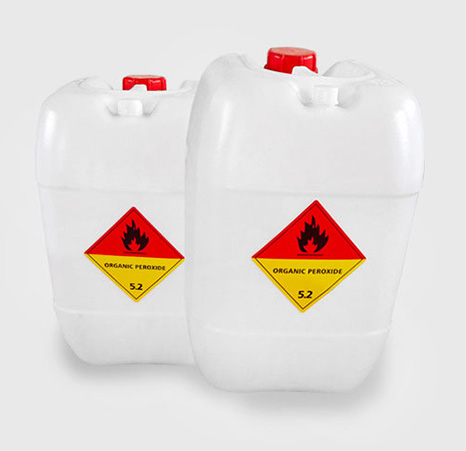Organic peroxide benzoyl
Tert butyl benzoate peroxide is a colorless to slightly yellow liquid. Slightly aromatic odor. Insoluble in water, soluble in organic solvents. It is widely used as an initiator in polymerization processes such as ethylene, styrene, propylene, vinyl acetate, diallyl phthalate, and isobutylene. In the curing process of unsaturated polyester, it is widely used in molding processes such as SMC, BMC, DMC pulling agents, and can also be used in two-component curing systems with higher activity such as MEPK, BPO, or TBPO. Store in a cool and ventilated warehouse. Keep away from sparks and heat sources, and prevent direct sunlight. The temperature of the warehouse should not exceed 30 ℃. Packaging sealing. It should be stored separately from reducing agents and alkalis, and mixed storage should be avoided. Equip corresponding types and quantities of fire-fighting equipment. The storage area should be equipped with suitable materials to contain leaks. Vibration, impact, and friction are prohibited. Chongqing Granular Peroxide Trimethylhexanoate Tert Butyl Ester!
The main varieties of organic peroxides include hydrogen peroxide (ROOH), dialkyl peroxide (ROOR), diacyl peroxide (RCOOOOCR), peroxide ester (RCOOOR), peroxide carbonate (ROCOOOOOR), and ketone peroxide [R2C (OOH) 2], each with different application characteristics. For example, benzoyl peroxide BPO is typically used as an initiator for free radical polymerization and a curing agent for unsaturated polyester; DCP can be used as a crosslinking agent and an initiator for melt grafting. Generally, the selection is based on four indicators: active oxygen content, activation energy, half-life, and decomposition temperature. Benzoic acid peroxide was an early and commonly used organic peroxide, which is a granular solid and thermally stable at ambient temperature. To improve safety, benzoic acid peroxide can be added with 22% or 30% (by weight) of water to form a wet product, reducing flammability and vibration sensitivity. In addition, there is a paste formula with a concentration of 25% to 50% benzoic acid peroxide.
The structural characteristics of the peroxide functional groups in organic peroxides determine that peroxides have the following chemical properties: (1) they have strong oxidation. (2) It has natural decomposition properties, and at temperatures above 40 ℃, most peroxide reactive oxygen species decrease. (3) Acids and alkaline substances can promote decomposition. Strong acids and hydroxides of alkali metals and alkaline earth metals (solid or high concentration aqueous solutions) can cause intense decomposition. (4) Organic peroxides such as iron, cobalt, and manganese, as well as redox system compounds, promote decomposition. (5) Strong reducing amine compounds and other reducing agents promote decomposition. (6) Iron, lead, and copper alloys can promote their decomposition. (7) Rubber can promote its decomposition. (8) Friction, vibration, or impact on storage containers can cause local temperature increases and promote decomposition.
The harm of reducing ammonia and deodorizing ammonia gas is greater than we imagined, and it can damage livestock and poultry at different stages. It can be summarized as affecting the production performance of breeding pigs, affecting the growth and development of piglets and fattening pigs. There have been numerous experiments to prove this, and we will explain it to you through a series of articles in the future. The National Clean O+Peroxide Disinfection Scheme can quickly reduce ammonia and odor, improve the air quality of pig farms, ensure safety and no residue, and improve the mucosal protection and health of pig herds. Most pathogenic bacteria die at pH<4 due to acidic oxygenation. Maintaining an acidic feeding environment is beneficial for cleaning the environment. At the same time, peroxide disinfection ultimately decomposes into harmless compounds and water, which can increase the oxygen content in the enclosure, promote hemoglobin conversion in pigs, and improve herd vitality.
The reactive activity of peroxyesters such as tert amyl phthalate and tert butyl phthalate is relatively low, resulting in good thermal stability. They can be stored at ambient temperature and used as vulcanization initiators for sheet model materials. When selecting peroxyesters, it should be noted that isopropylphenyl peroxyesters have a relatively high reaction activity, followed by tert octyl peroxyesters, tert amyl peroxyesters, and tert butyl peroxyesters. Peroxydicarbonate, an important peroxide used in industry, is highly toxic. All peroxycarbonate esters have essentially the same reaction activity. Peroxydicarbonate with higher molecular weight is safer and easier to control. 2-ethylhexyl peroxydicarbonate is an excellent initiator for the polymerization of vinyl chloride. The use of aqueous dispersion or lotion of peroxydicarbonate can further increase safety. In the PVC industry, there is a growing interest in this formula.
The optimization of production type has effectively driven the market demand of the chemical industry, and the overall scale of the industry has rapidly expanded. The field has been continuously expanded, the structure has been gradually adjusted, and the overall level has been greatly improved. The operation quality and efficiency have been further improved. Through production-oriented optimization and upgrading, the chemical industry has evolved from an initial focus on "three waste treatment" to an industrial system that includes environmentally friendly products, environmental services, clean products, and waste recycling, with a basic range of industries across industries and regions. Although the overall scale of China's chemical industry has grown rapidly in recent years, there is a significant gap between the competitiveness, income capacity, and per capita income indicators of limited liability companies (natural) and developed regions. In terms of per capita income and other indicators, some Chinese enterprises are less than 1/10 of the global priority enterprises.
Accelerating the improvement of key competitiveness of enterprises and cultivating enterprises and enterprise groups with competitive advantages is a weakness that China's chemical industry must make great efforts to fill. Limited liability companies (natural) should fully consider utilizing the energy generated by chemical processes to convert into steam, providing energy for the production processes of other factories, promoting the integration of production, energy, waste circulation, logistics, and infrastructure, in order to achieve excellent social, economic, and environmental benefits.



